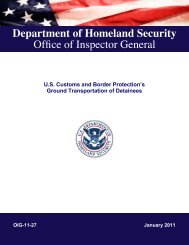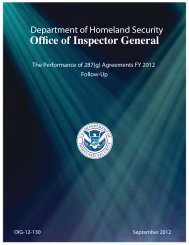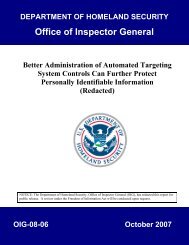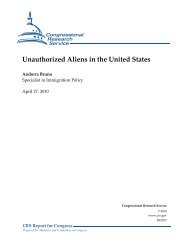Border Security and Unmanned Aerial Vehicles
Border Security and Unmanned Aerial Vehicles
Border Security and Unmanned Aerial Vehicles
You also want an ePaper? Increase the reach of your titles
YUMPU automatically turns print PDFs into web optimized ePapers that Google loves.
CRS-3On November 12, 2003, Congress agreed to the Department of Defense (DoD)Authorization Conference Report (H.R. 1588) which became P.L. 108-354 on November24, 2003. Section 1034 of the DoD Authorization Act requires the President to issue areport “on the use of unmanned aerial vehicles for support of homel<strong>and</strong> securitymissions.” UAVs were recently tested for potential domestic application on the U.S.-Mexican border. UAV demonstrations conducted by various commercial companies atFort Huachuca <strong>and</strong> Gila Bend, Arizona on behalf of the Department of Homel<strong>and</strong><strong>Security</strong>’s Customs <strong>and</strong> <strong>Border</strong> Protection (CBP) Bureau have prompted variousquestions regarding their potential use within the United States. Shortly after the ArizonaUAV demonstrations, DHS acknowledged that one model of UAV, the Predator B, wouldbe used in Operation Safeguard, an experimental law enforcement program that willconduct missions along the U.S.-Mexican border. 12 P.L. 108-90 on Appropriations forthe Department of Homel<strong>and</strong> <strong>Security</strong> provides $35.2 million to establish a Northern<strong>Border</strong> airwing, of which $12.8 million will be available for aircraft procurement. Indoing so, Congress supported functional <strong>and</strong> organizational Air <strong>and</strong> Marine Interdiction(AMI) <strong>and</strong> modernization efforts. Congress also tasked the DHS Under Secretary of<strong>Border</strong> <strong>and</strong> Transportation <strong>Security</strong> to devise a report outlining operational plans by whichthe Air <strong>and</strong> Marine Operations Center(AMOC) would eliminate surveillance gapsaffecting the northern border <strong>and</strong> western United States.Benefits <strong>and</strong> Limitations of UAVsOne potential benefit of UAVs is that they could fill a gap in current bordersurveillance. In particular, technical capabilities of UAVs could improve coverage alongremote sections of the U.S. borders. Electro-Optical (E-O) identification technology isadvanced enough that it can identify a potentially hostile target the size of a milk cartonat an altitude of 60,000 feet. 13 UAV’s also can provide precise <strong>and</strong> real-time imagery toa ground control operator, who would then disseminate that information so that informeddecisions regarding the deployment of border patrol agents can be made quickly.Another benefit of the UAV system is its loiter capabilities. The Predator B used inOperation Safeguard can fly for more than thirty hours without having to refuel. 14 TheUAV’s ability to loiter for prolonged periods of time has important operationaladvantages over manned aircraft. The longer flight times of UAVs means that sustainedcoverage over a previously exposed area may improve border security.UAVs are less expensive than other manned aircraft used on the borders. The unitcost of UAVs varies widely. The Shadow UAV costs $350,000 while the Predator costs12The Department of Homel<strong>and</strong> <strong>Security</strong>’s Bureau of Immigration <strong>and</strong> Customs Enforcement(ICE) evaluated the Predator B used during Operation Safeguard, which began October 29, 2003,<strong>and</strong> ended November 12, 2003. The General Atomics Corporation remotely piloted the PredatorB during simulated night <strong>and</strong> daytime border demonstrations.13Peter Hardin, “Eyes in the Skies,” Richmond Times-Dispatch, Oct. 30, 2003, p. F1.14For additional information regarding the Predator B technical capabilities see the GeneralAtomics website at [http://www.uav.com/products/predator_b_er.html].












